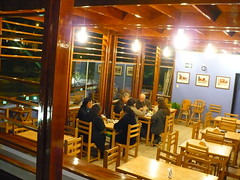Raqchi Ruins
We travelled closer and closer to the imperial city of Cuzco, along a similar route to which Inca founder and sun-child Manco Cápac would have walked. After rising from Lake Titicaca he headed west, looking for the ideal place to found his empire. His requirements were simple, the location had to have sufficient fertile surface soil – he would plunge his staff into the ground as he walked, always hitting rock in this barren landscape. Only when he reached the site of Cuzco was the soil abundant enough to settle.
Along this route is Raqchi, site of some pretty unique Inca ruins. These are the best, and to this extent only, surviving ruins that have adobe walls still sitting on a base of Inca rock walls. This was a normal feature in Inca architecture, all tall buildings were built like this, but thanks to the weather, and to the Spanish, little survives today.
Raqchi is the location where another Inca legend took place. Wiracocha, the Inca Creator God, preformed a miracle here. While moving northwards along the river, he was insulted by the local people, so decided to demonstrate his divinity. From the heavens he summoned a fire, one which engulfed the entire volcano behind him, then with his staff, put it out again. The people were impressed and quickly became a little more respectful.
So, in this location the Incas built a temple to Wiracocha, which is in the form of a gigantic hall measuring 92m by 25m, with a central dividing wall 12m high. It was the largest roofed Inca hall, covering 2000m2.
The site is a good example of the Incas building in trapezoids. You can see this in the shape of the door openings and in the thickness of the walls. This is a design feature intended to withstand earthquakes. Considering these Inca walls are still standing across the country, whilst the Spanish colonial buildings were destroyed in each and every earthquake, the Incas certainly had it right.
Again, uniquely in Inca architecture, the temple structure incorporates roof-supporting columns. These were 6m high and where halfway down the sloping roof. They supported the wooden beams of which the roof was built. One of these columns still survive, the others are about a metre high.
Near the temple are rows of Inca homes and storehouses. This is where the rich or important were housed. The entire complex was surrounded by a wall, outside of which the poor and the workers lived. Little of this wall still survives; it’s bricks were used by the people of the area to build their houses.
Photos below






![Peru’s Plans for Global (Foodie) Conquest [Featured]](http://farm4.static.flickr.com/3248/2894184868_5127efeb94_m.jpg)


